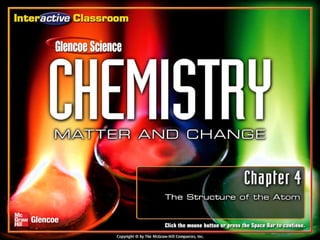Cmc chapter 04
•Transferir como PPT, PDF•
7 gostaram•2,513 visualizações
Denunciar
Compartilhar
Denunciar
Compartilhar

Recomendados
Recomendados
Mais conteúdo relacionado
Mais procurados
Mais procurados (20)
Chapter 6.2 : Covalent Bonding and Molecular Compounds

Chapter 6.2 : Covalent Bonding and Molecular Compounds
Chapter 3.1 : The Atom: The Building Blocks of Matter

Chapter 3.1 : The Atom: The Building Blocks of Matter
Destaque
Destaque (20)
Semelhante a Cmc chapter 04
Semelhante a Cmc chapter 04 (20)
Mais de Jane Hamze
Mais de Jane Hamze (10)
Último
Último (20)
UGC NET Paper 1 Mathematical Reasoning & Aptitude.pdf

UGC NET Paper 1 Mathematical Reasoning & Aptitude.pdf
Basic Civil Engineering first year Notes- Chapter 4 Building.pptx

Basic Civil Engineering first year Notes- Chapter 4 Building.pptx
Kodo Millet PPT made by Ghanshyam bairwa college of Agriculture kumher bhara...

Kodo Millet PPT made by Ghanshyam bairwa college of Agriculture kumher bhara...
This PowerPoint helps students to consider the concept of infinity.

This PowerPoint helps students to consider the concept of infinity.
General Principles of Intellectual Property: Concepts of Intellectual Proper...

General Principles of Intellectual Property: Concepts of Intellectual Proper...
Unit-IV; Professional Sales Representative (PSR).pptx

Unit-IV; Professional Sales Representative (PSR).pptx
Cmc chapter 04
- 2. Chapter Menu The Structure of the Atom Section 4.1 Early Ideas About Matter Section 4.2 Defining the Atom Section 4.3 How Atoms Differ Section 4.4 Unstable Nuclei and Radioactive Decay Exit Click a hyperlink or folder tab to view the corresponding slides.
- 4. Section 4-1 Section 4.1 Early Ideas About Matter (cont.) Dalton's atomic theory The ancient Greeks tried to explain matter, but the scientific study of the atom began with John Dalton in the early 1800's.
- 7. Section 4-1 Greek Philosophers (cont.)
- 9. Section 4-1 Greek Philosophers (cont.)
- 12. End of Section 4-1
- 14. Section 4-2 Section 4.2 Defining the Atom (cont.) atom cathode ray electron nucleus proton neutron An atom is made of a nucleus containing protons and neutrons; electrons move around the nucleus.
- 32. End of Section 4-2
- 34. Section 4-3 Section 4.3 How Atoms Differ (cont.) atomic number isotopes mass number The number of protons and the mass number define the type of atom. periodic table: a chart that organizes all known elements into a grid of horizontal rows (periods) and vertical columns (groups or families) arranged by increasing atomic number atomic mass unit (amu) atomic mass
- 38. Section 4-3 Isotopes and Mass Number (cont.)
- 43. End of Section 4-3
- 45. Section 4-4 Section 4.4 Unstable Nuclei and Radioactive Decay (cont.) radioactivity radiation nuclear reaction radioactive decay alpha radiation Unstable atoms emit radiation to gain stability. alpha particle nuclear equation beta radiation beta particle gamma rays
- 51. Section 4-4 Radioactive Decay (cont.)
- 56. End of Section 4-4
- 57. Resources Menu Chemistry Online Study Guide Chapter Assessment Standardized Test Practice Image Bank Concepts in Motion
- 72. IB Menu Click on an image to enlarge.
- 73. IB 1
- 74. IB 2
- 75. IB 3
- 76. IB 4
- 77. IB 5
- 78. IB 6
- 79. IB 7
- 80. IB 8
- 81. IB 9
- 82. IB 10
- 83. IB 11
- 84. IB 12
- 85. IB 13
- 86. IB 14
- 87. IB 15
- 88. IB 16
- 89. IB 17
- 90. CIM Table 4.3 Properties of Subatomic Particles Figure 4.12 Rutherford's Experiment Figure 4.14 Features of an Atom Figure 4.21 Types of Radiation
- 91. Help Click any of the background top tabs to display the respective folder. Within the Chapter Outline, clicking a section tab on the right side of the screen will bring you to the first slide in each respective section. Simple navigation buttons will allow you to progress to the next slide or the previous slide. The “Return” button will allow you to return to the slide that you were viewing when you clicked either the Resources or Help tab. The Chapter Resources Menu will allow you to access chapter specific resources from the Chapter Menu or any Chapter Outline slide. From within any feature, click the Resources tab to return to this slide. To exit the presentation, click the Exit button on the Chapter Menu slide or hit Escape [Esc] on your keyboards while viewing any Chapter Outline slide.
- 92. End of Custom Shows This slide is intentionally blank.